| dc.contributor.author | Tveit, Guro Møen | |
| dc.contributor.author | Anders, Neil | |
| dc.contributor.author | Bondø, Morten Steen | |
| dc.contributor.author | Mathiassen, John Reidar Bartle | |
| dc.contributor.author | Breen, Michael | |
| dc.date.accessioned | 2022-04-05T11:32:12Z | |
| dc.date.available | 2022-04-05T11:32:12Z | |
| dc.date.created | 2022-02-04T10:52:44Z | |
| dc.date.issued | 2021 | |
| dc.identifier.citation | Journal of Fish Biology. 2021, 1-10. | en_US |
| dc.identifier.issn | 0022-1112 | |
| dc.identifier.uri | https://hdl.handle.net/11250/2989927 | |
| dc.description.abstract | Wild capture can be stressful for fish. Stress has the potential to induce mortality in released unwanted catches or negative flesh quality consequences in retained ones. Such effects compromise sustainable natural resource management and industry profitability. Mitigating stress during capture is therefore desirable. Biological indicators of stress can objectively inform fishers as to the functional welfare status of catches during fishing operations. If they are to be of practical use in mitigating stress during wild capture events, such indicators must be quantifiable, respond rapidly, reflect the level of induced stress and be easily observable. Atlantic mackerel (Scomber scombrus) are extensively targeted by purse seine fisheries in European waters but are particularly vulnerable to stress. Excessive crowding in the net is thought to be the principal stress mechanism. There is therefore a need to develop indicators of crowding stress for this species so that catch welfare can be improved. Here, we demonstrate that S. scombrus exhibit a skin colour change from predominately green to predominately blue when exposed to crowding stress. In sea cage trials, we induced various degrees of stress in groups of wild-caught S. scombrus by manipulating crowding density and its duration. Skin colour was quantified in air using digital photography. The colour change occurred rapidly (within the typical duration of crowding events in the fishery), and its magnitude was correlated to the severity and duration of crowding. Bluer fish were also associated with higher levels of plasma lactate. No appreciable colour change was observed in uncrowded (control) groups during the treatment period. Nonetheless, unstressed S. scombrus did turn blue <1 h after death. Together, these results indicate that skin colour change has the potential to be a useful real-time indicator of crowding stress for S. scombrus and could therefore be used to improve welfare during wild capture fishing. | en_US |
| dc.language.iso | eng | en_US |
| dc.publisher | Wiley | en_US |
| dc.rights | Navngivelse 4.0 Internasjonal | * |
| dc.rights.uri | http://creativecommons.org/licenses/by/4.0/deed.no | * |
| dc.subject | stress | en_US |
| dc.subject | skin colour | en_US |
| dc.subject | iridophore | en_US |
| dc.subject | image analysis | en_US |
| dc.subject | crowding | en_US |
| dc.subject | Atlantic mackerel | en_US |
| dc.title | Atlantic mackerel (Scomber scombrus) change skin colour in response to crowding stress | en_US |
| dc.type | Peer reviewed | en_US |
| dc.type | Journal article | en_US |
| dc.description.version | publishedVersion | en_US |
| dc.rights.holder | © 2021 The Authors. Journal of Fish Biology published by John Wiley & Sons Ltd on behalf of Fisheries Society of the British Isles. | en_US |
| dc.source.pagenumber | 1-10 | en_US |
| dc.source.journal | Journal of Fish Biology | en_US |
| dc.identifier.doi | 10.1111/jfb.14987 | |
| dc.identifier.cristin | 1997709 | |
| dc.relation.project | Fiskeri- og havbruksnæringens forskningsfinansiering: 901350 | en_US |
| cristin.ispublished | true | |
| cristin.fulltext | original | |
| cristin.qualitycode | 1 | |

